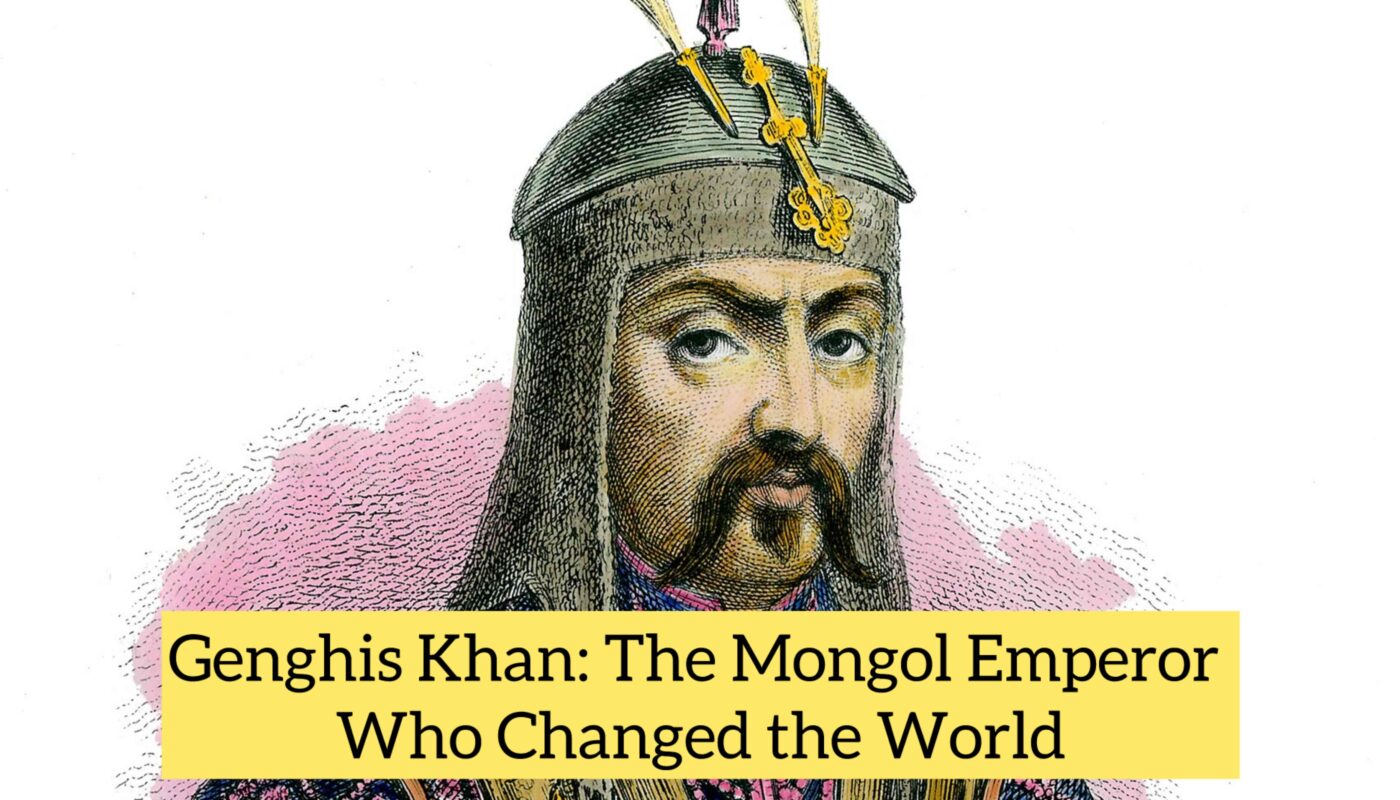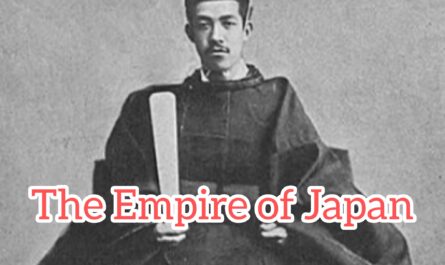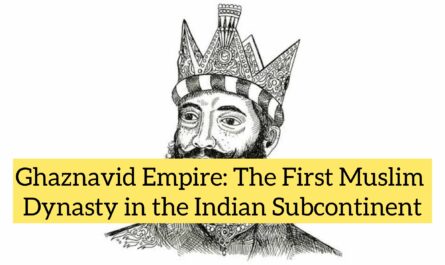Introduction
Genghis Khan (c. 1162 – 1227) is one of the most formidable and well-known conquerors in history. Born Temüjin in the Mongolian steppes, he rose from humble beginnings to unite the fragmented Mongol tribes and create the largest contiguous empire the world has ever seen. His empire stretched from Eastern Europe to the Pacific Ocean, influencing vast regions of the world, reshaping cultures, and changing the course of history. His legacy is marked by both ruthless conquests and significant advancements in governance, trade, and military strategy.
While often remembered for his brutal tactics and mass destruction, Genghis Khan’s reign also facilitated cultural exchanges and innovations that impacted the world long after his death. His leadership, military innovations, and vision of a united Mongol world were pivotal in shaping the modern world.
Early Life: The Making of Temüjin
Birth and Family Background
Genghis Khan was born Temüjin around 1162 in the Mongolian steppes, to a clan of the Borjigin tribe. He was the son of Yesügei, a prominent leader, and Höldün, his wife. The early years of Temüjin’s life were marked by hardship. His father was poisoned by the Tatar tribe when Temüjin was very young, leaving his family vulnerable to attack and internal strife.
After his father’s death, Temüjin’s family was ostracized, and they struggled to survive in the harsh Mongolian wilderness. The young Temüjin experienced significant adversity, including being captured by a rival clan, the Tatar tribe, and enduring harsh conditions in captivity. However, his early life experiences shaped his determination, resilience, and desire for unity among the Mongol tribes.
Formation of Alliances
At the age of 16, Temüjin began to rise to prominence. He freed his family and built a following by forming alliances with powerful Mongol leaders, including his blood brother Jebe and other important tribal leaders. Unlike many of his contemporaries, Temüjin sought unity among the Mongol tribes rather than simply conquering or subjugating them. This vision of a unified Mongol people, rather than fragmented tribes, would define his future conquests.
By the time he was in his mid-20s, Temüjin had begun to assert his authority over the Mongol tribes and had established a solid base of support. His leadership was built on meritocracy rather than traditional aristocratic structures, which set him apart from other tribal leaders.
Rise to Power
The Battle of Dalan Balzhut (1187)
Temüjin’s journey toward leadership began with significant military success. One of his first major victories came in 1187 when he defeated a rival Mongol leader, Toghrul, at the Battle of Dalan Balzhut. This victory marked the beginning of his rise to power and solidified his reputation as a capable and strategic military leader.
Defeating the Jin Dynasty
Temüjin’s military campaigns were marked by his strategic ingenuity, disciplined army, and use of psychological tactics. His first major military conquest was against the Jin Dynasty in northern China. After years of skirmishes, Temüjin managed to unite several Mongol tribes and launch a successful invasion of the Jin Empire in the late 12th and early 13th centuries.
His success was a combination of military prowess, effective use of cavalry, and his ability to break alliances among his enemies. The Jin Dynasty, which had been a powerful force in China, was severely weakened by his raids and military campaigns. Temüjin’s victory over the Jin Empire paved the way for his further conquests across Central Asia and China.
The Creation of the Mongol Empire
Unification of the Mongol Tribes
In 1206, after years of struggle, alliances, and betrayals, Temüjin managed to unite the diverse and often hostile Mongol tribes under his leadership. At a grand assembly known as the Kurultai, Temüjin was declared Genghis Khan, meaning “Universal Ruler.” This marked the official foundation of the Mongol Empire, and Genghis Khan’s leadership began in earnest.
Under his rule, the Mongol Empire became a force of unparalleled military power. He instituted various reforms to unify and consolidate power, such as codifying laws, improving military organization, and integrating a diverse set of people into his empire. His emphasis on meritocracy, loyalty, and discipline helped him build a formidable army composed not only of Mongols but also of soldiers from conquered peoples.
Military Innovations and Tactics
Genghis Khan revolutionized warfare in ways that had long-lasting effects on military strategy. His military innovations included:
-
The Mongol Horse Archers: Genghis Khan’s army was famous for its cavalry, especially its mounted archers, who were able to shoot arrows with incredible accuracy while riding at full speed. This mobility allowed them to outmaneuver and strike at enemy forces from unexpected directions.
-
Psychological Warfare: Genghis Khan used fear as a weapon. He would often massacre entire cities to create a reputation of ruthlessness, which would discourage other cities from resisting him. The sight of his army was enough to cause panic and submission among enemies.
-
Intelligence and Communication: Genghis Khan’s army utilized sophisticated intelligence networks and a system of communication involving mounted couriers who could relay messages across vast distances, ensuring that his strategies and orders reached his forces swiftly.
-
Siege Warfare: Despite the Mongols traditionally being seen as a nomadic cavalry-based force, Genghis Khan’s army adapted to siege warfare, using catapults, sappers, and engineers to conquer fortified cities like Samarkand, Bukhara, and Khwarazm.
Conquests and Expansion
The Invasion of Central Asia and Persia
By the early 13th century, Genghis Khan had begun his campaigns across Central Asia and Persia. One of his first major conquests was the Khwarezmian Empire, which controlled parts of modern-day Iran, Turkmenistan, Uzbekistan, and Kazakhstan. The Khwarezmian Shah, Ala ad-Din Muhammad, insulted Genghis Khan’s trade delegation, which prompted Genghis to retaliate with one of the most destructive campaigns in history.
The Mongol invasion of the Khwarezmian Empire was swift and brutal. Entire cities were destroyed, and many people were killed or enslaved. Genghis Khan’s tactics led to the complete collapse of the Khwarezmian state, and his reputation for ruthless vengeance was cemented.
Invasion of China and the Jin Dynasty
Following the fall of the Khwarezmian Empire, Genghis Khan turned his attention to China. His army, after years of sieging and warfare, eventually conquered the Jin Dynasty in 1215. This allowed Genghis Khan to control northern China, and it laid the foundation for the Mongols to eventually conquer the entirety of China under his descendants, including the Yuan Dynasty, established by his grandson Kublai Khan.
Invasion of the Western Steppes and Europe
After his conquest of Central Asia and China, Genghis Khan began looking westward toward the Caucasus and Eastern Europe. His invasions reached as far as Kievan Rus’ (modern-day Russia and Ukraine), where he devastated cities like Kiev. He also advanced into parts of the Middle East and Eastern Europe, pushing into Hungary and Poland.
Though Genghis Khan did not live to see the full extent of his conquests in Europe, his campaigns were the precursor to further Mongol invasions in the 13th century, which would have lasting effects on the region.
Death and Legacy
Death and Succession
Genghis Khan died in 1227, possibly due to injuries sustained during a fall from his horse or from a natural illness. His death was a significant blow to the Mongol Empire, but his son, Ögedei Khan, succeeded him and continued his father’s conquests.
Genghis Khan’s empire was divided among his sons and grandsons, each of whom ruled a portion of the vast Mongol territories. His descendants continued to expand and govern the empire, reaching their peak during the reign of Kublai Khan, who founded the Yuan Dynasty in China.
Cultural and Political Impact
The legacy of Genghis Khan is multifaceted. On the one hand, his conquests brought immense destruction, with entire cities obliterated and populations decimated. On the other hand, his empire fostered cultural exchange between East and West. The Silk Road flourished under Mongol rule, with trade, ideas, and technologies flowing freely between Europe, the Middle East, China, and Central Asia.
Genghis Khan’s legacy also influenced future military strategies and governance. His innovations in military tactics, organization, and the use of intelligence and psychological warfare became lessons for future generations of leaders.
Conclusion
Genghis Khan remains one of the most influential figures in world history. His rise from a humble background to become the ruler of the largest contiguous empire in history is a testament to his vision, leadership, and military genius. While his reign was marked by brutality and devastation, it also ushered in a new era of cultural exchange, trade, and global interaction. Genghis Khan’s impact on the world is still felt today, and his name continues to be synonymous with both destruction and the unification of vast and diverse lands under a single ruler.
Genghis Khan’s complex legacy—combining both conquest and cultural innovation—ensures his place as one of history’s greatest figures.



